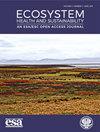鼠李属(C. zhaoguangii,鼠李科)新种及中国第三属
IF 3.4
2区 环境科学与生态学
Q1 ECOLOGY
引用次数: 0
摘要
摘要:在第二次青藏高原科学考察和研究的生物多样性调查中,在四川发现了一个鼠李科新种——赵光柱。本文对新物种进行了详细的描述和说明。到目前为止,该新种仅在横断山区金沙江流域的干热河谷中发现。与其他两种已知的中国蓝属植物相比,赵光ii具有灌木扭曲、叶片细小、先端微缺的习性。在形态上,这个新物种与马达加斯加特有的阿氏C.alloudii和墨西哥西北部的绿色C.viridis非常相似,而它与这两个亲缘物种的区别在于叶片上有微小的白色鳞片。赵光ii的发现再次提醒我们,底部区域对HDM的生物多样性保护也很重要,应该是植物区系调查的优先事项。本文章由计算机程序翻译,如有差异,请以英文原文为准。
The new species and the third Chinese member of Colubrina (C. zhaoguangii, Rhamnaceae)
ABSTRACT A novel species of Rhamnaceae, Colubrina zhaoguangii, is discovered in Sichuan, China, during the biodiversity investigations of the Second Tibetan Plateau Scientific Expedition and Research. Detailed descriptions and illustrations of the new species are presented herein. To date, the new species is only found in dry-warm river valleys of the Jinsha River basin in the Hengduan Mountains region (HDM). Compared with the other two known Chinese Colubrina species, C. zhaoguangii features by the habit of twisted shrub and tiny leaves with emarginate apex. In morphology, the new species highly resembles C. alluaudii endemic in Madagascar and C. viridis in northwestern Mexico, whereas it is distinguished from these two relatives by its minutely white scales on the leaf blades. The discovery of C. zhaoguangii reminds us again that the bottom region is also important for biodiversity conservation in HDM and should be a flora survey priority.
求助全文
通过发布文献求助,成功后即可免费获取论文全文。
去求助
来源期刊

Ecosystem Health and Sustainability
Environmental Science-Management, Monitoring, Policy and Law
CiteScore
7.10
自引率
2.00%
发文量
40
审稿时长
22 weeks
期刊介绍:
Ecosystem Health and Sustainability publishes articles on advances in ecology and sustainability science, how global environmental change affects ecosystem health, how changes in human activities affect ecosystem conditions, and system-based approaches for applying ecological science in decision-making to promote sustainable development. Papers focus on applying ecological theory, principles, and concepts to support sustainable development, especially in regions undergoing rapid environmental change. Papers on multi-scale, integrative, and interdisciplinary studies, and on international collaborations between scientists from industrialized and industrializing countries are especially welcome.
Suitable topics for EHS include:
• Global, regional and local studies of international significance
• Impact of global or regional environmental change on natural ecosystems
• Interdisciplinary research involving integration of natural, social, and behavioral sciences
• Science and policy that promote the use of ecological sciences in decision making
• Novel or multidisciplinary approaches for solving complex ecological problems
• Multi-scale and long-term observations of ecosystem evolution
• Development of novel systems approaches or modeling and simulation techniques
• Rapid responses to emerging ecological issues.
 求助内容:
求助内容: 应助结果提醒方式:
应助结果提醒方式:


